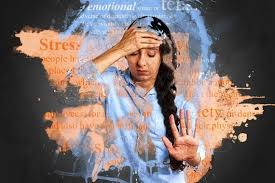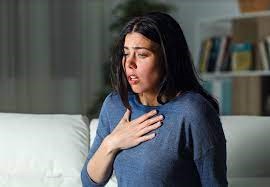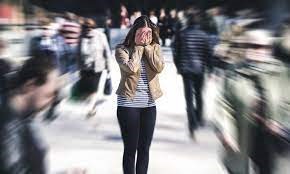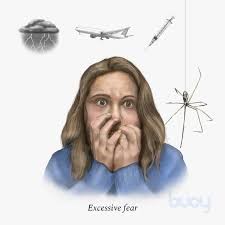Anxiety is 'REAL', Know more about Anxiety Disorders
- Harsharan

- Dec 21, 2021
- 9 min read

What is Anxiety?
Anxiety or worry is a normal human emotion like all other emotions which stems from stress. It’s a normal human reaction to a perceived threat in any situation. It comes with uneasiness, discomfort, nervousness, fear of what might happen. Generally, some levels of anxiety and worry is faced by all of us in our day to day lives but if we get overwhelmed with it and worry excessively, and when it disrupts the daily functioning of our mind and body, then it’s alarming and you might be suffering from anxiety disorder.
What can most commonly trigger Anxiety?
Most of us might not be aware that it also serves as a basic survival function. While facing any tensed situation, like, facing an interview, sitting in an exam or thinking about our future or feeling fearful about something like seeing a dog or a snake in front of you, we feel certain kind of sensations in our body like, racing heart-beat, tensed muscles, sweaty palms and forehead, cold hands, arms and legs shaking, discomfort in stomach that we feel like using a washroom. All these sensations are the fight or flight response of our body and this happens when we encounter any terrifying situation. During this time, our sympathetic nervous system gets stimulated and activates the adrenal glands in our body which release the hormone called adrenaline and other chemicals that prepare the body to get rid of the stressed situation. Now, the brain takes some time to process the information and to understand whether the threat is real, and if it is, then how to handle it. If the brain evaluates the situation to be non-threatening, then it gives the signal to the body and its fight or flight response is deactivated and the nervous system relaxes. On the contrary, if the processed information by the brain says that the threat may last longer, then the anxiety symptoms also continue for a longer time.
Feelings of anxiety can be mild or intense depending upon the situation and the personality of the individual. Mild anxiety can be feeling uneasy or nervous during a situation and intense anxiety can be feeling fearful, too much worried or can even lead to panic. The good news is that sometimes, anxiety is also helpful because it makes the person alert and focused and enables him to give his best, for example, while preparing for the exams, anxiety helps the students to be focused and prepare hard as a result of which they give excellent results.
Let's know about the disorders that are related to anxiety called as Anxiety Disorders
Anxiety becomes a disorder when it is intense and obstructs the daily flow of your life, affects your sleep or changes your behavior. Anxiety disorders are certain mental health conditions that are among the most common ones. They are of different kinds and have different symptoms. They affect all age groups-children, adults and teenagers. Be it any kind of anxiety disorder but all have one thing in common: it occurs frequently and is very strong and affects the well- being of an individual. The symptoms can stem up all of a sudden or can build up over a period of time and continue till the person realizes that something is actually wrong. Sometimes it becomes so overwhelming that the person starts having a feeling of hopelessness not understanding from where it has come.
Anxiety Disorders
1. Generalized Anxiety Disorder (GAD)

Generalized anxiety disorder is characterized by patterns of frequent, persistent excessive worry and anxiety which is not restricted to any specific events or circumstances. This is excessive and prolonged worry which typically involves minor or everyday matters like, work, finances, relationships, routine tasks or safety and health of loved ones. Individuals suffering from GAD generally do not acknowledge their excessive worry but they are preoccupied with many things and are unable to control it. This is also called as Free Floating Anxiety, means, anxiety which is not related to any specific set of events or circumstances but happens in all situations or tasks. This disorder is found to be more in women and usually has its onset in late adolescence or early adulthood.
The clinical characteristics of GAD are:
Excessive, persistent and frequent worry.
Restlessness.
Easily fatigued.
Difficulty in concentrating.
Irritability in most activities.
Muscular tension.
Sleep disturbance.
2. Obsessive Compulsive Disorder(OCD)
It is an anxiety disorder characterized by obsessions and compulsions. Obsessions are persistent, repetitive thoughts, ideas or images that come in mind of the individual and are experienced as irrational and intrusive. These individuals can very well make out that these obsessions are coming from their own mind from nowhere. In attempt to stop them or ignore them, they tend to distract themselves by doing some other repetitive actions called as compulsions. This behavior is repeated to reduce the distress caused by those intrusive thoughts in individuals. Elaborate rituals are an example of compulsions, it’s a particular sequence of actions which the person is compelled to do and if by any chance the sequence is broken or any step missed out, the whole ritual is repeated all over again.
It is important to note over here that all repetitive thoughts are not obsessions for example, when we say, “He is obsessed with music”, this obsession in not related to that OCD, here it means that the person is indulging in the activity with his own will in order to derive pleasure from it and there is no compulsion of any kind.

Let us have a look at some of the common obsessions and compulsions:
Obsessions
Repeated thoughts about contamination from dirt, germs, urine or faeces.
Repetitive doubts (whether doors, locks, taps gas stove knobs are closed, lights are off or not).
A need to arrange the things in a particular order like, arranging books, shoes, clothes in the cupboard very neatly.
Fearful thoughts that they might hurt someone physically.
Having unacceptable sexual thoughts and images.
Compulsions
Washing and cleaning hands excessively, bathing, tooth brushing, excessive cleaning of objects used by others, excessive grooming.
Counting (number of stairs and tiles used for walking).
Repetitive checking of doors, locks, taps, lights, gas stoves.
Arranging the objects in a particular sequence.
Repeating daily activities.
Re-reading and re-writing.
OCD is the most common and severe anxiety disorder and affects 1 to 3 percent of population once in their lifetime. It occurs in all age groups. Though OCD is a common illness, many who suffer from it do not take any treatment but it should be noted that if it is left untreated, it can become chronic and can worsen even more during stressful conditions
3. Panic Disorder
Panic disorder can be seen as panic attacks which happen to a person with a feeling of intense apprehensions or fearfulness. The person fears of approaching impending doom. Panic attacks usually last for several minutes but in some cases can even last longer (for hours). These attacks occur during any stressful condition like, any fearful or dreadful situation (a dog or a snake), in a crowd (fear of being in a crowded place) or after any traumatic condition (death of a loved one or an accident).
Clinical Characteristics or symptoms:
Pounding heart or palpitations
Sweating
Trembling or shaking
Breathlessness or shortness of breath
Choking sensation
Feeling dizzy or lightheaded and unsteady
Nausea
Fear of losing control or going crazy
Numbness or tingling sensations
Restlessness
The symptoms develop abruptly and reach a peak in 10 minutes of the first symptom noticed.

Types of panic attacks: There are three distinctive types of panic attacks:
Unexpected panic attack- This occurs unexpectedly from nowhere, without relating to any situation.
Expected panic attack- Occurs with exposure to any situational trigger for example, seeing a snake, dead body, lizard or facing an interview.
Panic attacks predisposed to certain situations- Likely to occur on exposure to any situational trigger but is not always associated with the trigger and does not occur just after any situational trigger, for example, while driving but there are times when individuals drive and there are no panic attacks or there are times when panic attack occurs after an hour of driving.
4. Agoraphobia
It refers to anxiety towards avoiding places and situations where a person feels that there is difficult and no escape or is afraid that help might not reach while facing a panic attack. The predominant irrational fears in agoraphobia are:
Fear of not finding any escape
Fear of losing control in front of others
Fear of moving away from home
Fear of falling down
Fear of not getting help if something went wrong
It should be noted that the above given irrational apprehensions cause a person to avoid certain situations like:
Being alone at home and outside home
Being alone in the crowd like market place, cinema halls, railway and bus stations.
Travelling alone in a car
Being alone on a bridge or in an elevator.
People who suffer from agoraphobia can better face the fearful situation when accompanied with someone whom they trust. The severity of this disorder can make a person fully home bound and constant presence of family members. It can develop anytime during the course of panic attacks particularly during the first year of onset of repetitive panic attacks.
5. Somatoform Disorder
This disorder is related to the body where a person feels multiple physical symptoms like, abdominal pain, headaches, back ache, neck pain, joint pains, nausea vomiting, impaired balance and unusual sensations of discomfort which cannot be explained by the presence of any medical condition or illness. Hence, these symptoms are also called as “Medically Unexplained Symptoms.” Individuals who complaint of these symptoms generally exaggerate them and put forth in a dramatic way. All the possible laboratory investigations would be normal but still, the symptoms occur. These individuals do not agree with the physician that there is no medical explained medical condition for these symptoms. Hence, the patients drop out and they start doctor shopping and seek treatment from various doctors, would repeatedly undergo the laboratory investigations but the results rule out the presence of any illness.
It should be noted that these physical symptoms are not intentionally created by the individuals and they disrupt the daily normal routine of the person, the social activities and also the relationships. Somatoform disorder has an onset typically before the age of 25yrs in 90% of the population with this disorder

The risk factors of this disorder are:
Severe stress triggers
Marital/family discord
Poor social support
Financial loss
6. Phobia
Phobia is a feeling of intense fear of certain animals, objects or places but this intense feeling of fear does not match the situation. It makes the person avoid the everyday situations. Some specific examples of phobia include the fear of: - snakes, spiders, heights, flying, blood or injections, travelling in a lift.
7. Social Anxiety Disorder
As the name suggests, this is the fear of being in social situations which involve strangers, people of opposite sex. People suffering from social phobia resist from going in the gatherings. They avoid these situations because of low self-esteem or fear of being judged or criticized. They feel nervous and anxious to perform certain activities in front of others like speaking, giving a presentation, discussing and meeting others. The social situations can be, weddings, parties, group meetings, interviews, presentations. They are nervous of making eye contact with others. In extreme cases it can also result in complete social isolation.
8. Post- Traumatic Stress Disorder (PTSD)

PTSD is developed after a person is subjected to an extreme traumatic situation. A traumatic situation involves, either the person experiencing it personally or witnessing it accompanied by the feeling of helplessness, horrified during the event. The common traumatic situations are: War, fire accidents, vehicular accidents, death of a loved one, kidnapping, rape/molestation, physical abuse, floods, cyclones, earthquake. Greater the proximity and intensity of the trauma, the greater will be the possibility of developing psychiatric symptoms. Individuals with PTSD also feel guilty of being survived when all others could not and is called as “Survivor’s Guilt”.
The clinical characteristics for recognizing PTSD are:
Repetitive, intrusive distressing memories about the traumatic situation.
Repetitive images and thoughts of the traumatic situation.
Dreams and nightmares about the traumatic event.
Repetitive flash backs.
The individual engages in avoiding the triggers by experiencing numbness in responsiveness which is indicated by:
Avoiding thoughts and feelings or conversations associated with the event.
Decreased interest in daily activities.
The individual is unable to experience any emotions and does not feel to lead a fulfilling life by getting married, or making a career.
Difficulty in falling asleep.
Excessive display of anger.
His social and occupational functioning is impaired.

PTSD can have an onset at any age, including childhood. The psychiatric symptoms usually begin within the first three months of the traumatic event but can also take longer time to begin, sometimes, a year.
Treatment for Anxiety Disorders
There are many treatment options for people suffering from Anxiety Disorders but Treatment is the only option for this cluster of disorders.
We are just outlining the probable treatments, however it is advisable to go for professionals for these treatments.
Psychotherapy Counselling is an effective treatment for all the anxiety disorders.
Cognitive Behaviour Therapy works really well to reduce anxiety symptoms especially for OCD
Behavioural Therapies are used to reconstruct corrective behaviours to address the anxiety
Medications: Co-morbid conditions (excess stress, depression, OCD etc.) might require psychiatric medications e.g. anti-depressants can help in treating anxiety along with psychotherapy.
Alternative Therapies: Yoga, Meditation, use of Soothing and Calming materials like Greent Tea, Water, Fragrance, Music etc.
Hope this article was helpful to you all. If any queries or concerns do contact us atblissfulminds@gmail.com
We at Peaceofmind are always striving to reach out to the community and working towards our mission to safeguard mental health.




















Comments